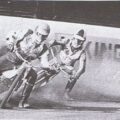[av_textblock textblock_styling_align=” textblock_styling=” textblock_styling_gap=” textblock_styling_mobile=” size=” av-medium-font-size=” av-small-font-size=” av-mini-font-size=” font_color=” color=” id=” custom_class=” template_class=” av_uid=’av-l4gu2rs7′ sc_version=’1.0′ admin_preview_bg=”]
Paisley Lions
All Text is By Bill Elliot (thanks Bill)
In the early part of 1975, St Mirren’s Love St stadium was certainly causing a buzz amongst the local sporting fraternity.
Not only was there a young manager by the name of Alex Ferguson beginning to do great things with his youthful Saints’ squad, which would take Scottish football by storm over the next few years, but there was an exciting new sport (at least in Paisley) which was about to grab the public by the scruff of the neck on a Saturday night-speedway. The sound of 500cc bikes, none of which were equipped with brakes, became a regular feature at Love St for the next two summers, providing converts with a different form of adrenalin rush, and a few new members from foreign shores within the ranksteam on the track, local businessman and former Glasgow Tigers front man Neil MacFarlane and well known promoter Joe Thurley, and the two gathered many thousands of air miles in their efforts to bring thrills and spills to the newest speedway track in the West of Scotland, with the Tigers at Coatbridge forming the deadliest of local rivalries for the next two summers.
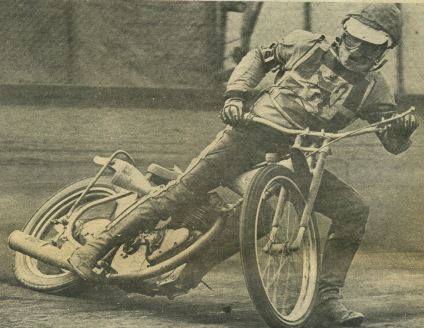
[/av_textblock]
[av_textblock textblock_styling_align=” textblock_styling=” textblock_styling_gap=” textblock_styling_mobile=” size=” av-medium-font-size=” av-small-font-size=” av-mini-font-size=” font_color=” color=” id=” custom_class=” template_class=” av_uid=’av-l4gu3753′ sc_version=’1.0′ admin_preview_bg=”]
Unlike football at that time, when most of the sporting stars were local lads (or were at least Scottish), with only a few of their members coming from foreign parts, the Paisley Lions came from all over the world, with Kiwis, Aussies and Englishmen picking up team spots. With the long Love St straights providing riders with the chance to turn their throttles wide open, speeds in excess of fifty and sixty miles an hour were by no means unique as the respective teams provided a very fast, not to say exhilarating, form of entertainment to the faithful who turned out in numbers in the early days of the sport in Paisley.
On the first night, on 5 April, 1975, the Lions got off to a perfect start when they beat the reigning champions, Birmingham Brummies, 41-37 in a match which attracted a crowd of 6,100, not too shabby for a first night, and certainly on a par with that which St Mirren were pulling in to watch the football.
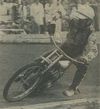
The co-existence of the two sports proved to be an interesting logistical operation every two weeks, when St Mirren kicked off at 3.00pm, while the Lions began racing at 7.00pm. For obvious reasons, track preparation couldn’t go on in the middle of a football match, while the safety fence, an essential feature in speedway meetings, couldn’t be erected until the football was finished so, some weeks, the pre-speedway entertainment took the form of watching track staff hurriedly erect the wooden fence, each section of not inconsiderable weight, as quickly as was humanly possible. The scenes were occasionally reminiscent of the end of a Benny Hill Show sequence, when it appeared that the staff’s hard work had been fast forwarded to ensure their absolute deadline of 7.00pm was met, and that the meeting started on time!
On track, while the Lions were never in contention for the League title, they nevertheless provided a special brand of excitement. The regular seven man team after the opening couple of weeks in 1975 comprised the Sheldrick brothers from Blackpool, skipper Sid and younger brother Mick, Kiwi Mike Fullerton from Auckland, Cornishman Chris Roynon, young Aussie Stu Mountford, exciting newcomers Tom Davie and Bernie (Burnett) Foot, while in mid season Englishman Alan Bridgett joined the ranks and bolstered the middle ranks when injury and indifferent form inevitably depleted the squad. The pairing of Davie and Foot in particular caused much last second joy regularly in the meetings, as almost to a script either or both of them would often would perform an eleventh hour swoop past an unsuspecting visitor and beat them to the finishing line for an unlikely victory.
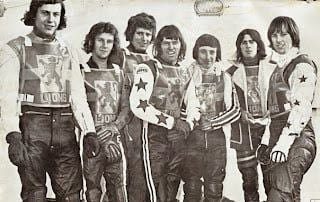
Several meetings in the course of their home fixtures over the two years were famous (or should that be infamous?) for varying reasons; Paisley staged a star studded Festival of Paisley meeting in midweek at Love St, not traditionally a great night for attracting large crowds to speedway, but the promotional skills of Neil MacFarlane were shown to the full as a massive 14,873 people turned up to watch a very special night in the West of Scotland, with World Champion Ivan Mauger beating American superstar Scott Autrey 2-1 in a best of three match race series, his world famous gold plated bike took centre stage on the track infield, and skipper local rivals Glasgow Tigers, Brian “Pogo” Collins, finished ahead of a strong field to win the trophy,
On another night, the high flying Newcastle Diamonds visited Paisley and, much to the consternation of the southern press, who were convinced a 46-30 scoreline MUST have been misreported, they were soundly beaten by the home side. Indeed, such was the visitors’ desperation for a victory, in the middle of the meeting, they demanded a measurement of the width of the track, the minimum permitted width (in old money) at any point being 25 feet. A huge cheer erupted from the home crowd when it was announced that in fact the track had been measured at several suspect points and found to be the minimum length, and it was only 35 years later, at a Paisley Lions Reunion, that MacFarlane revealed that 3 inches of the measuring tape had mysteriously found its way up his sleeve on the night, allowing the track to “pass” its inspection. It was rumoured that, thereafter, St Mirren had to take corner kicks from that side exactly that distance closer to the goal…….
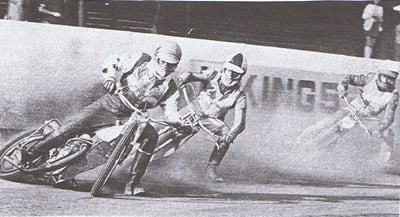
Another big individual meeting at the track, the Championship of Strathclyde, saw a different result at the end of the night, and one which brought considerable pleasure to the home support, as unsung home rider, Mick Sheldrick, who formed a useful partnership with big brother and skipper Sid during the latter’s time at Paisley, was a surprise winner of the prestigious trophy. Mick actually only rode speedway for four seasons, so the feat in picking up the award during his limited career shouldn’t be underestimated, and it brought great joy to the home support to see one of “their own” (as all the Paisley riders quickly came, in spite of wherever in the world they had originated from), all of them quickly becoming honorary Buddies) was one of the highlights of the Lions’ two years in existence.
In the context of home riders doing the business, so to speak, the Youth Championship which the Supporters Club ran at the end of the second season was perhaps the final highlight in what turned out to be a less than successful second period for the club. The “big team” had an away match in deepest England, and so the club’s supporters decided to give their members a meeting anyway, and ran the meeting (with a lot of help from other parties like Tigers’ promoter Jimmy Beaton, and Tigers’ captain Brian Collins), and a real community effort saw an excellent meeting comprising riders who hadn’t quite yet broken into their team, full of spills, passing and all the other elements you put into the archetypical speedway night), and best of all, a home winner in the shape of up and coming Lion Colin Caffrey, who went on to break into the Lions team just before the end of the season, before going on to enjoy a fine career at Berwick, then Glasgow, for the next 10 years or more, recording a notable victory over then World Champion Peter Collins in the process.
While the Lions staged some notable meetings over the course of their two years, unfortunately the second season was one in which they suffered regular challenges which, alas, took their toll. They had a disastrous start to the season, not winning a home league match until June (from an April beginning), which had the inevitable downward effect on crowds and thus revenue. Skipper Sid Sheldrick was sold to Scunthorpe early in the season which, while staunching the flow of money out of the club, weakened them on the track. They had signed Colin Farquharson from Berwick, and his heavy scoring did help ease the pain, but with fellow Kiwi Mike Fullerton, the track record holder, not returning till mid season, a heavy burden was placed on the other riders to raise their scoring levels, and that load proved in most instances to be beyond their best efforts. The entertainment level continued to be high, but visiting riders had a tendency to get to the finish line before the Lions, and fans drifted away. The overheads associated with a club as far north as Paisley in the UK were considerable, with the cost of air fares, accommodation, and other factors ensuring that their overseas riders’ costs would always be a factor in an unequal battle to balance the books.
Towards the end of the 1976 season the promotion announced that the losses incurred were likely to prevent a third season in 1977. The supporters sprang into action and a number of fundraising ventures raised a considerable amount of money towards paying off the debts, including a memorable fundraising dance days before Christmas when they met the cost of flying in Ivan Mauger (he of the golden bike) to the social event, which raised a colossal sum of money as people flocked to the event to see a real world champion, but unfortunately, in spite of their best efforts, failed just short of the sums required. The supporters group took on the running of the club but, to be fair, the level of expertise and business acumen in any event might possibly have been beyond the group of ever willing enthusiasts, and in March 1977 it was announced that the Lions were no more.
The name of “Paisley” did continue for a year or two, however, as a Scottish Junior League, a forerunner of organised national competition for newcomers to the sport, was formed, and the Lion cubs competed in the SJL for a few seasons, funded by the ever responsible Supporters Club, racing out of Coatbridge and Blantyre, the then home of the Glasgow Tigers, but eventually that, too, came to a halt and the Lions were no more. They have, however, made brief comebacks in the form of two reunions, one in 2011, then another in 2015, both well attended by former “Love St Lovers” and, as if to show the bond which exists between the fans, riders and promotion after all this time, representatives from the riding and promotional staff flew in from all over the world to attend either or both of these events, some came from the far flung corners of the UK, while others sent messages of support from all parts of the globe, just to be part of a very special club which, nearly fifty years after it was formed, still has a very special place in so many people’s hearts. It might be a bit fanciful to suggest the Paisley Lions might sometime get together on the track, but the bond is strong enough to suggest that another coming together as one by the folk who remember the days of the Lions with huge fondness might yet one day all meet at the same time, and the same place, even if a few of them might be getting on a bit in years. You never know, do you…….
[/av_textblock]


